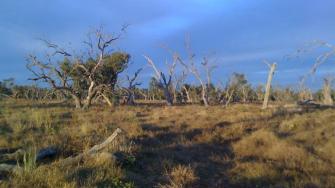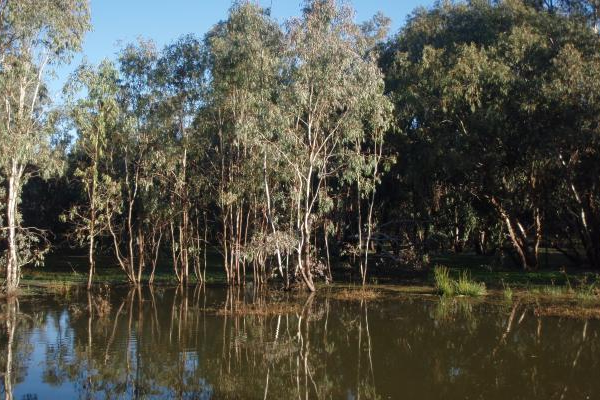
Supervisors:
Abstract
River red gum carbon is an important source of allochthonus carbon in naturally productive dryland riverine floodplains of the Murray-Darling Basin.
It supports basic trophic levels extending up through complex floodplain food webs to support higher biota such as native Australian fish and birds. Floodplain food webs are also highly valued for their rich and productive arable agricultural land, resulting in riverine floodplains being under-represented in reserves. The swift pace of river modification caused by damming and water extraction for agricultural purposes has pushed water regimes beyond the adaptive capacities of many floodplain biota, including river red gum. Floodplain management during extended periods of drought and the impacts of climate change threaten to further limit the availability of already stretched water allocations for environmental purposes. The extension of inter-flood interval and loss of riparian vegetation communities, including river red gum, heralds a shift from aquatic floodplain ecosystems to terrestrial ecosystems where grasses and chenopod shrubs dominate.
This study focused on the differences between three inter-flood interval floodplains (short dry period between floods of 1-3 years, moderate- dry period between floods of 4-7 years and long- dry periods of >8 years) in the Macquarie Marshes to test three hypotheses; there is a gradient of declining carbon resource availability as ecosystems shift from aquatic to terrestrial, there is a gradient of differences in emergent microinvertebrate biodiversity and carbon utilisation as ecosystems shift from aquatic to terrestrial and river red gum carbon will be preferentially utilised by emerging microinvertebrates over other carbon sources when available.
As IFI extended floodplains declined in river red gum organic (bio-available) carbon, increased in autochthonous carbon (i.e. algae) and finally shifted to dominance of carbon from terrestrial plant communities including grasses and chenopods. This trend confirmed the ‘terrestrialisation’ of the Marshes, which has been explored in past studies. Extended IFI also caused a decline in emergent microinvertebrate diversity, however the exact mechanism for this was not discovered, as river red gum carbon utilisation was not consistent across microinvertebrate groups. Cladoceran diets were closely associated with shifts in river red gum carbon availability, whereas ostracod (a closely related taxon) diets were not. Nonetheless the study confirmed past studies which demonstrate extended interflood interval as an agent for decline in floodplain wetlands. River red gum was consumed preferentially by cladocerans, subject to its availability in floodplains. As floodplain carbon resources shifted, cladoceran diet followed, shifting from river red gum, to authochthonous sources and then to the consumption of terrestrial carbon. This pointed to the dependence of cladocerans, a large microinvertebrate often targeted by predatory fish and wading birds, on the availability of river red gum carbon and highlighted the importance of river red gum as an allochthonous carbon input.
This study also highlighted stable isotope analysis as a useful tool in floodplain management to assist setting flooding restoration targets. Stable isotope analysis elucidated changes in floodplain resources availability and micro-scale linkages at a basic trophic level. This is particularly pertinent as changes in microinvertebrate ecology are often early warning signs of declining in floodplain health. This study showed how the impacts of extended drying of floodplain wetlands can cascade through food webs, impacting carbon sources that support higher trophic biota such as waterbirds and fish. These findings can be used by river managers to set targets for restoration of floodplain wetlands food webs and provide easily measured indicators for evaluating the success of environmental flow allocations.
Key findings:
- Short IFI patches supported healthy live red gum of similar size to the moderate IFI patches where the red gum had died due to lack of flooding.
- River red gum carbon pools decline as extended inter-flood interval cause a ‘terrestrialisation’ of the Macquarie Marshes.
- Patches most regularly flooded were richest in river red gum carbon and most often supported higher species diversity, suggesting the importance of allochthonous carbon.
- River red gum was a major dietary source for cladocerans in floodplain microcosms, subject to its availability.
- River red gum did not notably contribute to ostracod diets which had more generalist diets than cladocerans in all IFIs.
- Extended IFI, caused by water regime modification, as an agent of biodiversity decline amongst larger emergent microinvertebrates.




